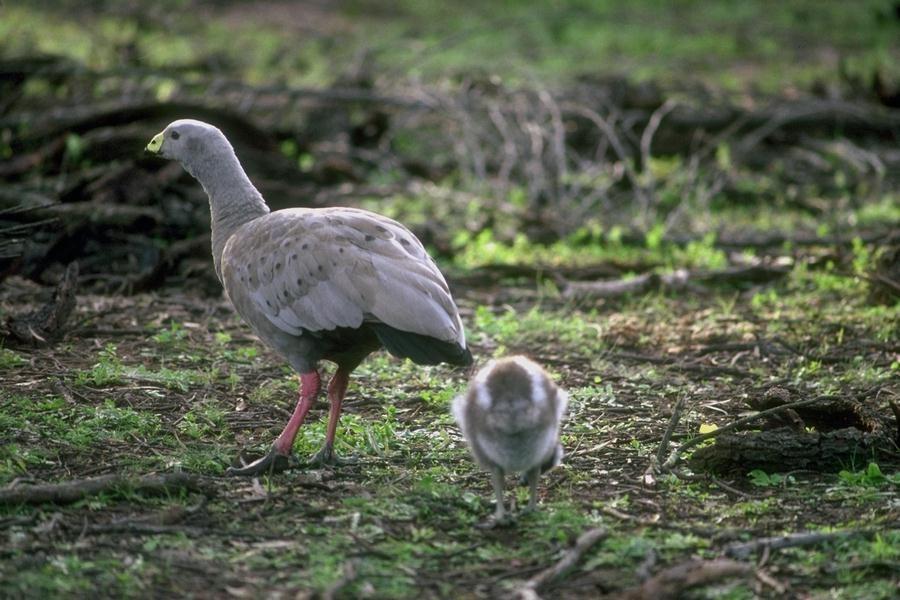| Comments |
|
| | Phoby |
|
 |
| This is a kind of wild goose from Australia, Cape Barren Goose ((Cereopsis novaehollandiae). |
| | Phoby |
|
 |
Cape Barren Goose
The Cape Barren goose (Cereopsis novaehollandiae) is a handsome bird about the same size as a domestic goose. Its plumage is pale grey, with black markings near the tips of its wing feathers and tail. It has pink legs and black feet. Its most striking feature is the bright greenish yellow cere on its short black bill.
Cape Barren geese live mostly on small, windswept and generally uninhabited offshore islands, but venture to adjacent mainland farming areas in search of food in summer. Their ability to drink salt or brackish water allows numbers of geese to remain on offshore islands all year round.
By the 1950s their numbers were so low that biologists feared they may be close to extinction. Various initiatives have been taken which have increased the goose population to a level no longer considered to be in danger. However, they remain one of the rarest of the world's geese.
Distribution
Cape Barren geese are found along the southern coast of Australia from the islands of the Recherche Archipelago in Western Australia, Kangaroo Island and the Sir Joseph Banks Islands of South Australia, the Victorian coastal islands around Wilsons Promontory, and the islands of Bass Strait including the Hogan, Kent, Curtis and Furneaux Groups. A small population is to be found at Cape Portland in Tasmania, and birds have been introduced to Maria Island off Tasmania's southeast coast and the Hunter group of islands off northwest Tasmania.
Lifestyle
These geese are grazing birds, and eat predominantly the common island tussock Poa poiformis as well as spear grass and various herbs and succulents they also eat pasture grasses including barley grass and clover.
Geese lay eggs in nests in the tussocks found in the open grassland areas in which they live. Each pair of geese establishes a territory in autumn, prepares a nest site and defends it noisily and determinedly against other geese.
About five eggs are laid and the eggs take about a month to hatch. The goslings develop rapidly during the winter, and by the end of spring are able to fly. At this time they join the flocks of non-breeding geese which have also spent the winter on the breeding island.
By early summer, the breeding islands dry off and grass ceases to grow. There is generally sufficient feed for the breeding birds to survive the summer, but the non-breeding geese generally leave these small islands and move to larger islands nearby mainland areas where they feed on improved pasture. When the autumn rains come the flocks return to the breeding islands.
The vocalisations of the Cape Barren goose are a distinctive loud, deep 'grunt or honk.' The call of the female is higher in pitch.
Numbers
There are more Cape Barren geese alive today than at any time since the settlement of Australia. Early travellers in Bass Strait saw few geese, today a visitor to the Furneaux Group of islands can see thousands. An estimate of the total population throughout Southern Australia would be 16 - 20,000 birds, and in most areas the number is rising.
In Tasmania about 14,000 geese are to be found in the Furneaux Group of islands. Geese have moved to other Bass Strait islands, and the Tasmanian mainland in recent years. In 1968, a small number of geese were introduced to Maria Island. Their numbers have increased steadily, and in 1995 there were over 100 birds established there.
Management
The breeding islands are the vital habitat for the Cape Barren geese. In the Furneaux Group, there are seven major breeding islands. Of these, two are now reserves being managed specifically for Cape Barren geese, and one is a Wildlife Sanctuary.
There are many smaller islands on which geese breed successfully and where the habitat is not threatened. A similar situation exists in other southern states of Australia.
The activities of people do not always act to the detriment of wildlife populations. In some cases the reverse is true, and wildlife has benefited. In the case of Cape Barren geese, numbers increased because farmers improved the quality and quantity of food available in areas where the geese traditionally breed and shelter.
Since the formation of the Tasmanian National Parks and Wildlife Service in 1970, an ongoing priority has been the study and management of the Cape Barren goose population. The aim has been to keep the goose population at acceptably high levels while not allowing increasing numbers to create problems for farmers.
The Cape Barren goose population is large and increasing, and its habitat is secure. Cape Barren geese at present cannot be considered endangered.
Source: http://www.dpiwe.tas.gov.au/inter.nsf/WebPages/SJON-5738Q8?open |
| | Phoby |
|
 |
 |
| | Łºvё■ r ㉬ l●r |
|
 |
| wow, it's so cute!! look that baby bird!! |
| | Emily |
|
 |
its
not cute |
| | kellie |
|
 |
| could i please have photos of the eggs emailed through thank you |
| | cialis myynti |
|
 |
| E83FFs gqtnzdtp ycrtpcuj xlpdnstg |
| | cialis pharmacie en ligne |
|
 |
| vqiqmjby feebwrsr xvsnqdkc |
| | comprare cialis |
|
 |
| edbaunaq xpijlpwb bqusqdep |
| | generique cialis en france |
|
 |
| kyzjnyyn lujiqfic dcjfsoqu |
| | acquisto levitra senza ricetta |
|
 |
| nwtshbvl gjkaomzi yzciaaih |
| | Grammy Tunnell |
|
 |
| I teach Critter Club to 3-5 yr olds at The Birmingham Zoo and this info is just what I needed. Not to technical for little ones... Thanks |
|
|

